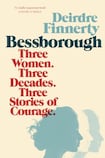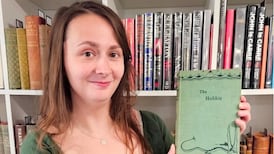
Bessborough House in Co Cork has been the focus of a lot of attention in recent years, not for its interesting architecture or its gardens, or its 19th century Quaker owners, but because of the huge number of women who gave birth there, and the huge number of children who were born there and died there, or were adopted from the institution when very young.
This book recounts the experiences of three women, Joan McDermott, Terri Harrison and Deirdre Wadding, who gave birth in Bessborough in 1968, 1973 and 1981 respectively. The sections devoted to each woman bring us through their early lives, their families’ reactions to their pregnancies, their arrivals at Bessborough, the births of their children, the removal of those children for adoption, and their mothers’ seemingly endless searches for them later in life. Of the four children born to these women, all were eventually found, but one, heartbreakingly, did not wish to be reunited with his mother.
Deirdre Finnerty, an experienced journalist, explains her methodology at the beginning: “This book is a work of creative non-fiction. The scenes recreated in this book come directly from interviews with the contributors, portrayed to the best of their memories. As much as possible, I have included dialogue as quoted to me verbatim in interviews, occasionally edited for clarity, but when it was not, I have deduced it from the contributors’ versions of events. Some names and details have been changed to respect the privacy of individuals.”
This is a clear account of how the author used the material she gathered from the three women to whom she spoke; she also went back to them with finished chapters for their approval. As a result, we are assured that the women who experienced the hardships of family and societal disapproval, of control of their pregnancies, births and children by church and State, and of serious obstruction of their efforts to be reunited with their children, are happy with this representation of what happened to them. This is a very different and welcome approach to survivors’ memories to that of the Commission of Investigation into Mother and Baby Homes, published in January 2021.
The three women chosen by Finnerty are first-class noticers; they remember clothes they were wearing at the times in question, decor in their homes, workplaces and dancehalls, what Bessborough looked and felt like, how the nuns and other inmates spoke to them, the food they ate, what their children looked like, and what it was like to see them again after a great deal of time had passed.
A volunteer who came to visit her and gave her some posh shampoo, quickly moved from kindness to business when she asked about her child's future and strongly urged adoption
All three spent some months in Bessborough and left shortly after the births of their children, all of whom were adopted. All three had to take assumed names for their stay. None of the three got support from their families. All three had rudimentary ideas about sex and pregnancy. Two of the three reported contemptuous abuse from the nuns in Bessborough, and lack of begged-for pain relief during childbirth – “you were doing the devil’s work”. All three lost their children to a closed adoption system which gave them no rights to see them again, and spent many years trying to find them. (In Joan McDermott’s case, she eventually discovered that while she had been searching for her son for 12 years, he had been searching for her for nine. The callousness of the individuals who prevented two grown adults from finding each other for so long is inconceivable.) All three had marriage difficulties.
Terri Harrison was abducted from her aunt’s house in London (with the aunt’s collusion) by a priest and two nuns in 1973, flown back to Ireland and deposited in Bessborough. Although she has told this story many times, it still feels incredible. But this time, we get a sense of a young woman’s total confusion and lack of agency in the face of a determined conspiracy to insert her in a powerful system. She had naively assumed that she could keep her baby (and of course she could have, in London in 1973), but that rational plan is completely overwhelmed by a coalition of relatives and the church against which she is powerless.
Terri’s is the saddest story of the three, because after many years of seeking to be reunited with her son, Niall (name changed), he finally sent her a message that he didn’t want to meet her, although he wished her no harm. Her striking phrase to describe her loss: “How do you grieve someone who is still alive?” Her section of the book ends with a beautiful, heartbreaking letter she wrote to him in 2020, which he may never read. If he happens to read this book, who knows? Reunions don’t always work out, but even unsatisfactory ones answer crucial questions for both parties.
The fact that the book covers the 1960s, 1970s and 1980s gives us a view of how things changed in Bessborough over the decades, reflecting changes in the broader society. By the late 1960s the devastating and notorious death toll of babies there (923 in 1922-1998) had been halted, but numbers of inmates were surging. Joan found herself in the traditional role of the penitent atoning for her sins, and treated by the nuns as such.
There are thousands of people born in mother and baby homes and elsewhere who wish to, and have a right to, see the files confirming their birth identities
When Terri arrives in 1973 things have softened a little, but often with the ulterior motive of ensuring children were adopted. A volunteer who came to visit her and gave her some posh shampoo quickly moved from kindness to business when she asked about her child’s future and strongly urged adoption.
Deirdre, arriving in the early 1980s in Bessborough and Dunboyne (she had two pregnancies), encountered more kindness but was still subject to overwhelming pressure to have her children adopted. This was eight years after the introduction of the Unmarried Mothers’ Allowance and seven years after the foundation of Cherish, the support organisation for unmarried mothers and their children.
None of this is over. There are thousands of people born in mother and baby homes and elsewhere who wish to, and have a right to, see the files confirming their birth identities. There is a forthcoming Bill making its glacial way through the Oireachtas that should finally legally grant that right. Then, an unwilling and obstructive State and church apparatus will have to give up the secrets they have hoarded for so long.










